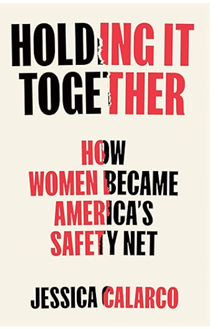By Jim Heffernan
I think it was the words “safety net” in the title that drew me this to book. I’ve long felt that the deterioration in our society could have been prevented with a more robust “safety net.” Other countries have it, why can’t we?
The author grabbed me with this statement about our deficient safety net in the preface of her book, “This sad state of affairs is the product of policy choices we’ve made over and over again. Choices to rely on women to hold it together for their families, their communities, and the whole economy, and choices to deny women the support they deserve for their toils. As I’ll explain, these policy choices drag all Americans down, albeit to varying depths. These choices have also rippled out from childcare and served as justification for underinvestment in other aspects of our social safety net, like healthcare and eldercare — because if women are the ones we expect to care for the children, then we might as well ask them to take care of the sick and elderly while they’re at it. And that’s how the systems in place come to affect far more than just women — undermining the security and stability of everyone else in American society too.”
Sometimes the preface of the book fools me. But not this time. Her style and sharp perceptions held me throughout the book.
The author includes sketches of the lives of more than a dozen women to illustrate the points she makes. Her subjects vary from poor single mothers to struggling couples in varied stages of affluence. What binds them together is the consistent refrain of the woman doing more than her fair share.
The driving force behind this situation seems to be a series of myths that we accept without serious questioning. One of them is the DIY (do it yourself) myth that somehow makes it seem wrong to seek help from others. Then there’s the “meritocracy myth” that tell us that if you’re not doing well, you’re just not working hard enough. And there’s the “super mom” myth that tells moms they should be able to do it all. These myths hold down middle and working class people and disproportionately benefit the rich and powerful.
In her conclusion, she makes a fascinating comparison between Iceland and the United States.
On October 24, 1975, the women of Iceland took the day off from paid work, housework, and childcare and took to the streets in a demonstration. Shops and banks had to close, husbands were forced to take children to work or else stay home. Sausages sold out because that was all most husbands could cook.
When the demonstration happened, Iceland and the U.S. had an identical HDI (Human Development Index) of 0.57. The HDI compares life expectancy, education, and per capita income to measure a nations well being. Today, Iceland’s HDI is third among developed nations while the U.S. ranks 20th among developed nations. I suspect even the rating of 20th is distorted by including the ultra-rich in the average.
Iceland also managed to elect a woman president in 1980.
This book is available at Cloud and Leaf Bookstore and Tillamook County Library. It was published in June of 2024. It is 316 pages long and 114 pages are acknowledgements, notes and index.
As always, discussion welcome at codger817@gmail.com


